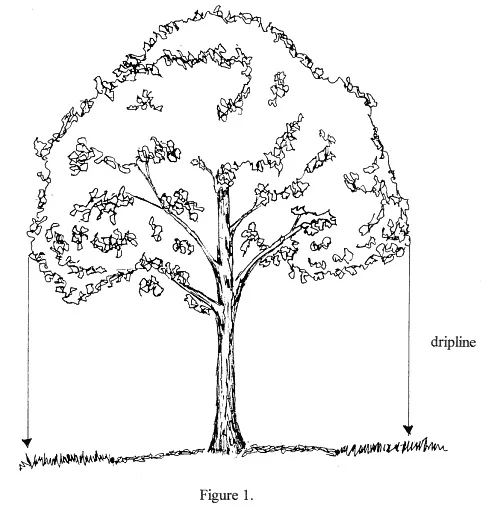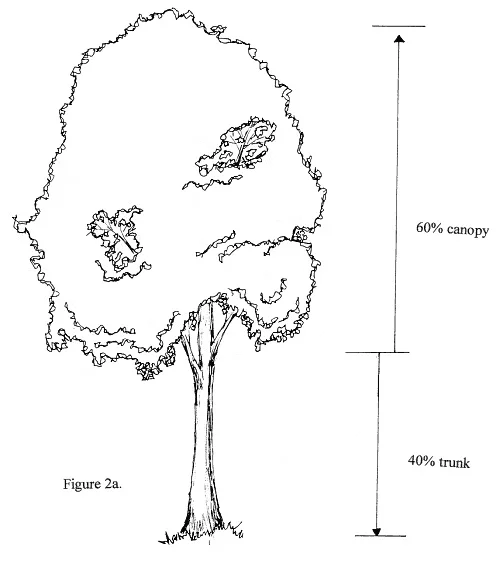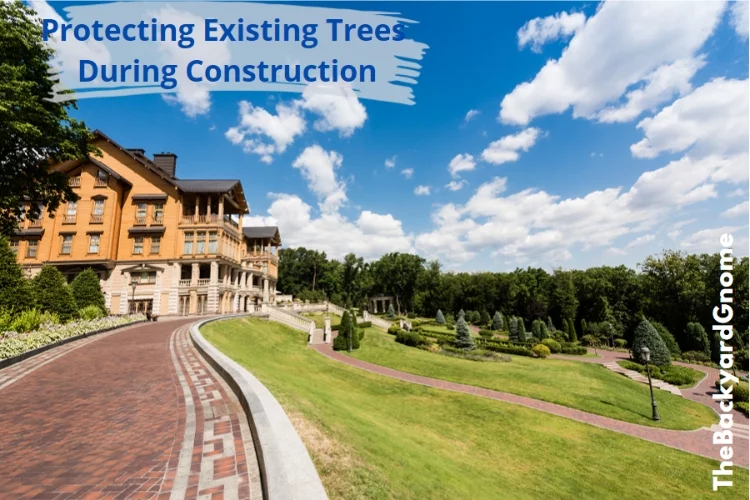Protecting Existing Trees During Construction
by Simmy Parker
Working around existing trees or under their canopies can be harmful to the trees. If you are planning to do work under the tree canopy or dripline of the tree it will be beneficial to read this article first and decide if the tree you will be working under is worth saving and how to protect it from stress.
Trees have an extensive root system that is required to maintain the health of the tree. The majority of roots are located within the top 12 inches of soil and extend past the dripline of the tree. However, the main area of concern is within the dripline of the tree's canopy. The dripline can be determined by dropping an imaginary line from the outermost leaves to the ground, as seen in figure 1. This area makes a circle around the tree and is considered the protected root zone. Any work in this area should be done with extreme care.
Contents
- Determining Whether a Tree Can Be Saved
- Making Vertical Cuts or Lowering Current Grade
- Making Vertical Cuts
- Lowering the Current Grade (Horizontal Cuts)
- Digging Trenches
- General Rules for Cutting Roots
- Filling or Increasing Current Grade
- Adding soil to just one side of the tree
- Aeration
- Planting Under Canopy
- Tips for Tree Care Before and After Damaging Work

The easiest way to avoid damage is to reconsider the work to be done. Remember there is usually more than one way to do a job. If you plan to build a patio with pavers that will require cutting or lowering the grade underneath a tree, consider instead building a wood deck. Wood decks are built above the soil line and the only disturbance to the root system will be digging the foundation post holes. This option decreases root disturbance and soil compaction and will more than likely keep the tree healthy and alive.
Remember to contact your utility companies to find out where it is safe to dig before digging.
Determining Whether a Tree Can Be Saved
Age of Tree. Younger trees will survive changes better than older, more mature trees. If the tree is overly mature and in poor condition, it might be best to remove it and replace it with a new tree.
Sensitivity to Root Disturbance. Trees vary in sensitivity when their roots are cut or the soil around their roots disturbed.
Sensitivity to Soil Compaction. Trees also vary in sensitivity to the soil around their roots being compacted. For example, using heavy equipment or raising the soil grade often causes soil compaction. Basically, soil compaction decreases the amount of oxygen in the soil that trees need to survive.
Health of Tree. If trees are already stressed and unhealthy in appearance the likelihood of surviving a major change in their current environment (loss of roots or grade change) can be minimal. On the other hand, a healthy, vigorous tree should live even after losing half of its root system. However, it is often difficult for a person to determine whether a tree is healthy. Following are some guidelines to help you decide:
Young trees are generally healthier than older trees.
Diseased trees increase the chance of loss. A good way to determine if a tree is diseased is to check whether:the tree has excessive dieback of the canopy or branches, the tree turns to fall colors early, the tree loses leaves early in the season.
Ratio of canopy (leafed out part of tree, deciduous trees only) vs. trunk. A healthy tree has 60% canopy to 40% trunk (see figure 2a). An unhealthy tree has 40% or less canopy to 60% or more trunk (see figure 2b).
Making Vertical Cuts or Lowering Current Grade
Some trees are more sensitive to root disturbance than others. Try to avoid disturbing more roots than necessary no matter how tolerant the tree is of root disturbance. The less the soil is disturbed around and underneath a tree, the healthier and more vigorous the tree will be. See the table in the publication Protecting Trees from Construction Damage: A Homeowner's Guide, published by the University of Minnesota Extension. Check under root disturbance for your specific type of tree. Keep in mind that if your tree is tolerant of root disturbance, but is unhealthy, it might be best to consider the tree as being intermediate or sensitive before cutting away roots. On the other hand, if your tree is young and healthy yet considered sensitive, it might be possible to make the maximum cut.
Making Vertical Cuts
These usually involve removing the entire root system, 12 inches or deeper.
- If the tree to be worked under is tolerant of root disturbance avoid removing more than 25 percent of the roots under the dripline.
- If the tree is intermediate avoid damaging roots inside the dripline.
- If the tree is sensitive to root disturbance extend the protected root zone beyond the dripline.
Lowering the Current Grade (Horizontal Cuts)
- Do not remove soil within 3 feet of the trunk.
- Take no more than 2 inches off the top three feet away from base of tree. Reducing the current grade 2 inches will already remove a good portion of the viable roots, so do not go deeper or chances of losing the tree increase. However, if you still need to remove more:
- Build a Retaining Wall. To reduce the amount of grade change within the protected root zone, create steps of grade changes (figure 3). Starting at a point past the dripline, keep in mind the sensitivity of the tree to root disturbance and cut away the current soil line making a vertical cut. Build a retaining wall, back fill with soil, and mulch around the tree.
- If the tree is sensitive to root disturbance, remove tree and plant a new one once the grade change has been made.
Digging Trenches
Trenches should only be dug on one side of the tree. To find the minimum distance from the tree trunk that the trench can be dug, determine diameter of tree at breast height (dbh) by measuring the diameter or width of the tree at 4.5 feet off the ground. Multiply the dbh by 0.5 feet to get minimum distance from tree to start trenching.
dbh x 0.5 feet = minimum distance from tree to start trenching (in feet)Keep in mind this is the minimum distance, however, it is always best for the health of the tree to maximize this distance. So if possible go a few feet beyond this amount or, preferably, go outside the dripline.
Augering When augering for fence posts, deck footings, etc., multiply dbh (see above) by 1 foot
dbh x 1 foot = minimum distance from tree to auger (in feet).Again this is a minimum distance. If possible, extend this outward a few feet or outside the dripline.
General Rules for Cutting Roots
- Water tree a few days before work will be done.
- Work only on dry soil. If soil is wet, any weight will compact the soil which will cause more stress on the tree.
- Make sure cuts are done with hand tools that will make clean, quick cuts (i.e. chainsaw and axe are best). Do not use large equipment like backhoes and bulldozers.
- Do not disturb roots more than necessary.
- Make sure cut roots are covered with soil and wood chips as soon as possible. If roots are going to be exposed for more than an hour, cover roots with a damp cloth. Be sure to keep cloth moist until soil and mulch can be used for permanent cover.
- Water the tree thoroughly when job is done. Wet first 12 inches of soil within the tree dripline.
- Put a permanent three foot (minimum) diameter ring of mulch around base of tree. Mulch 3-5 inches deep and keep the mulch away from trunk. Wood chips, shredded bark, or lawn trimmings can be used for mulch. Most types of mulch break down in time, so it is necessary to replenish the mulch from year to year.
- Twenty percent of the tree's roots can be cut before any signs of stress will appear, however, keep in mind that tree roots do extend outside of the protected root zone.
Filling or Increasing Current Grade
- Before adding soil or increasing the grade within the protected root zone, check how sensitive or tolerant the tree is to soil compaction. However, just because your tree is considered tolerant of soil compaction does not mean it will survive. If the tree is unhealthy and mature, the tree might tolerate less fill than if it were newly planted and healthy. Take into consideration all aspects mentioned above in Determining Whether Tree Can Be Saved when deciding how much soil can be added.
- If the tree to be worked under is tolerant of soil compaction, the maximum amount of soil added to the protected root zone is 24 inches. No more than 24 inches should be added within the protected root zone.
- If the tree is intermediate. avoid adding more than 6 to 12 inches of soil to the protected root zone.
- If the tree is sensitive to root compaction, 0 to 6 inches of soil may be added.
- When adding soil to increase the grade within the protected root zone, never allow the excess soil to touch the trunk or base of the tree. This will cause rot, which can kill the tree no matter how healthy. To keep soil away from the base of the tree, build a retention wall around the trunk (see figure 4). This wall can be made of key stone or treated wood. Build the wall 3 feet away from the trunk. When adding soil, it is advisable to add the lower half of soil as class 5 fill. This is often used in making a foundation for patios and sidewalks. The upper half should be a porous soil mix of one part of each of the following: loam, coarse sand and shredded bark.
- If fills deeper than suggested above are necessary, build a retaining wall on or outside the dripline. Backfilling should be done as above, with half the depth class 5 fill and half porous mix. Aeration is necessary when adding large amounts of fill (see below).
Adding soil to just one side of the tree
If it is necessary to fill on only one side of the tree, the best method is to use the equation for Trenching mentioned above. However, if the situation requires filling closer to the tree than recommended, do not fill closer than 3 feet from the trunk of the tree.
Aeration
Aerate within the protected root zone before and after grade changes. Starting 3 feet from the base of the tree, drill 2-inch diameter holes into the soil about 1 to 1-1/2 feet deep. Drill the holes in a circle 3 feet away from the trunk, spacing them two feet apart, then go out 5 feet and drill again in a circle. Continue every 2 feet within the protected root zone (see figure 5). Use the porous soil referred to previously to fill the holes.
Planting Under Canopy
- Do not add more than 6" total of soil and/or mulch.
- Keep mulch away from base of tree; any wood chips or soil that come in contact with the trunk of the tree will promote rot of the tree trunk.
- Never till soil under canopy; do not overwork the soil under the tree.
- Work soil with hands and hand tools only, no large equipment.
- Ground covers and/or mulch around the tree protect its roots and the soil from compaction and maintain soil moisture.
- Do not plant within 3 feet of the tree trunk.
- Do not plant anything within dripline that will compete with the tree for moisture and nutrients, such as another tree or large shrubs. Ground covers, perennials and small shrubs can be beneficial to the tree, acting as a barrier to soil compaction and improve moisture content by shielding the soil from direct sun exposure. Avoid planting anything that will be more than one-third the mature height of the tree (see figure 6).
- Avoid cutting roots from one inch diameter and up. If roots are encountered, move plant hole over a few inches, or until you can dig without encountering large roots.
Tips for Tree Care Before and After Damaging Work
- The best time to start making a tree more resistant to work around its roots is a year before the work begins. Trees store water and nutrients for times of need. These times can be in the spring, during droughts, after a hailstorm, etc. So extra stores of water and nutrients will create a healthier, stronger tree and will increase survival following the stress of damaging work.
- Trees should be watered a few days before work is to begin and again as soon as possible after the work is done. Thereafter, watering should be done thoroughly and infrequently. Make sure the ground is moist a foot deep within the dripline of the tree. Avoid getting the leaves of the tree wet while watering and try to water in the morning, rather than in the evening.
- Fertilizing should be done about a year before the work is to begin. This will help the tree store up needed nutrients for the next few years. Whether or not to fertilize after the work is done, depends upon the damage done to the tree. If roots were cut, do not fertilize the tree for a year. If the soil was compacted or fill was added, fertilizing the tree after the work is done may be beneficial. Use a slow release fertilizer, preferably organic, with only a couple pounds of nitrogen per 1000 square feet.
- If root loss has occurred, do not thin out the canopy of the tree. If this is done after root loss, you are decreasing the amount of root growth that can occur, since the chemical that stimulates the roots to grow is located in the tree's buds. Plus, even if you thin out the canopy, the tree might still have dieback. Wait only one to two years before pruning, then only cut out the dieback that has occurred.
- If the grade is to be increased, aerate the soil within the dripline before and after the work is done. By aerating the soil you will not only increase the chance of survival, but also help to create healthier, more vigorous growth in the future. For best results aerate the soil once every two years.

References:
Miller, N. L., D. M. Rathke, and G. R. Johnson, Protecting Trees from Construction Damage: A Homeowner's Guide, (FO-6135-GO) University of Minnesota Extension Service, St. Paul, MN. FO-7848-C, 1998.
Lichter, J. M. and P. A. Lindsey, "Soil Compaction and Site Construction: Assessment and Case Studies," The Landscape Below Ground: Proceedings of an International Workshop on Tree Root Development in Urban Soils, pp. 126-129, 1993.
Miller, F. D., Jr., "The Effect of Trenching on Growth and Overall Plant Health of Selected Species of Shade Trees," The Landscape Below Ground: Proceedings of an International Workshop on Tree Root Development in Urban Soils, pp. 157-164, 1993.
The Morton Arboretum, Lisle, Illinois, Tree Care Handbook, Nature Study Publishers, Rochester, NY 14616, 1994.
Harris, R. W., J. R. Clark and N. P. Matheny, Arboriculture: Integrated Management of Landscape Trees, Shrubs and Vines, Prentice-Hall, Inc., Upper Saddle River, NJ 07458, 1999.
Prosser, T., "Construction Damage to Trees,"Minnesota Horticulturist, Vol. 118, No. 5: pages 12-13, May 1990.
Personal Interview with Gary Johnson, Extension Educator and Associate Professor Urban and Community Forestry. Urban Forestry Building. May 18, 1999.
 |
 |
 |
 |

About Simmy Parker
Simmy is an outdoor expert who loves to spend time in the wilderness. She received a BS degree in Civil Engineering at Sacramento State University, and has put her skills to use by helping design and build some of the most impressive structures in the world. However, Simmy's true passion lies in sharing her love of nature with others, and she spends much of her free time leading hikes and teaching people about the flora and fauna that can be found all around them.
Thoughts on "Protecting Existing Trees During Construction"
 |
 |
 |
 |
Backyard Stuff
You can Get FREE Gifts. Receive Free Backyard Items here. Disable Ad Blocker to get them all now!
Once done, hit anything below
 |
 |
 |
 |